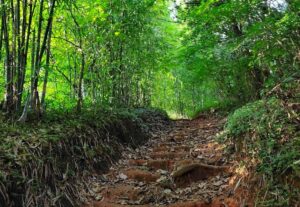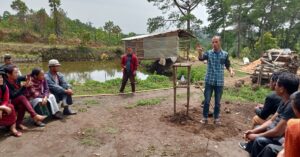Mandalgre, nestled in the East Garo Hills district of Meghalaya, is the highest village in Garo Hills, and is the home of the Manda clan. This close-knit community boasts a unique system of self-governance that has protected their surrounding forests for generations.
Mandalgre’s land is dominated by verdant forests, with two-thirds of the area covered in lush greenery. This includes the community forest, where residents can gather resources like firewood, bamboo, timber, wild edibles etc. for personal use. Excessive cutting down of trees and overharvesting is, however, prohibited. Selling these resources outside the community is an offence and a fine of Rs. 5000 is imposed on the violation of this rule.
The Manda clan also fiercely guards their ancestral reserve forest, known as Durama. This sacred hillock has been off-limits for logging for over thirty years. Any attempt to cut trees or remove forest products from Durama results in a hefty fine of Rs. 30000. The severity of the fine reflects the community’s deep respect for preserving this pristine area.
These regulations were set by the headman, together with the Secretary and other members of the community to safeguard their land from any internal or external encroachment and exploitation. This system of local governance ensures protection of their rich biodiversity, maintaining its sustainability for the years to come.
Mandalgre’s rich history is further reflected in landmarks like the Sanja Rong·gop, a cave once inhabited by the legendary Sanja Manda, the unsung hero of the Garos, who was one of the pioneers in opposing British rule in the region. The Sanja Ro·ong, a big rock which was once said to have been easily lifted by the legend can be seen till today, where visitors test their strengths and amuse themselves by trying to lift its weight with their bare hands.
When asked about her views on why she thinks there is a need for conservation, Pemodinni M Sangma, a traditional knowledge holder, asserted, “We need to keep our forests alive. If there are no forests or no trees, we will not get fresh air to breathe, and our rivers and waterfalls will run dry, and there will be no life. We are home to the mighty Simsang, the longest river in Garo Hills, so imagine, what if there was no Simsang. Therefore, we have to continue the rich cultural heritage and carry on the legacy of the generations before us, and fight against anything that stands in the way of conserving our resources gifted freely by mother nature.”
One can surely boast of having laid eyes on the tranquil and serene green sights of Mandalgre, with rustling brooks, and cascading waterfalls, such as Wari Andalchip, Mandal Dare, Singsing Mongera Dare, among many others. The Manda clan is doing a commendable job in ensuring that these treasures are cared for.
Within the Garos’ matrilineal society, family lineage and inheritance pass through the female line. Challina M Sangma, the village chief, and the Manda Matriarch, embodies this tradition. While she holds ultimate authority, she can delegate power and duties to her husband, Tebush N Sangma, who then acts as the headman or Nokma.
This remarkable system of self-governance predates the involvement of any wildlife department. It stands as an example of the Manda clan’s unwavering commitment to protecting their environment and preserving their heritage for generations to come.
This story has been documented as part of the TNC-supported NESFAS’ project “Protection of forests in Meghalaya by adopting participatory, gender-centric, and equitable approaches”.






